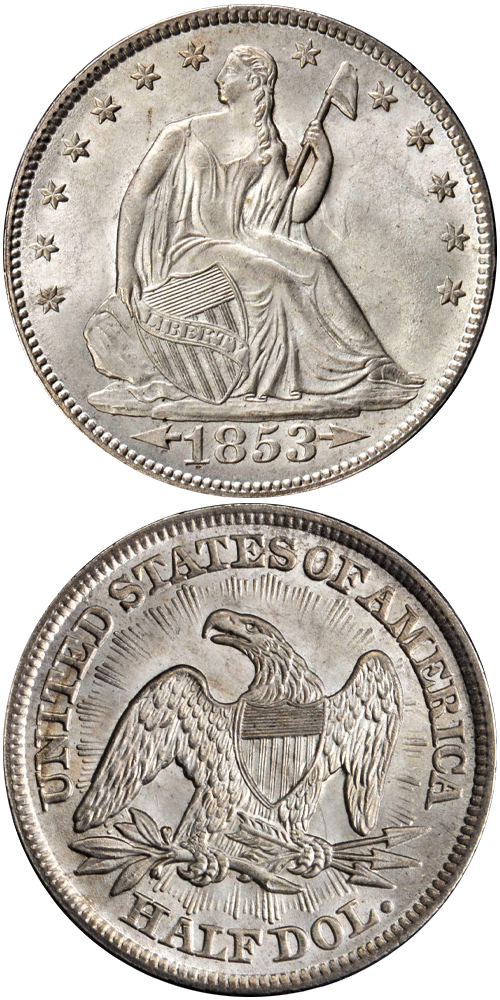1853 Liberty Seated Half Dollar
Arrows and Rays
The half dollar was the largest denomination affected by the wholesale weight reductions introduced to United States silver coinage through the Act of February 21, 1853. (In deference to its status as the nation's standard monetary unit, and also in recognition of the fact that the denomination did not see widespread circulation at that time, the weight of the silver dollar was left unchanged.) The new weight standard for the half dollar was 12.44 grams, as opposed to 13.36 grams for preceding issues produced beginning in the late 1830s. The weight reduction was introduced to return the half dollar to active circulation in the Eastern states, from where they had disappeared through hoarding (along with other fractional silver coins) as the price of silver rose in response to the vast quantities of gold being mined in California during the Gold Rush. In essence, silver had become scarce relative to gold in the market of the early 1850s, and old tenor pieces were quickly removed from circulation as their bullion value exceeded their face value. The Act of February 21, 1853, reduced the weight of the half dollar and other fractional silver coins to the point where they could circulate once again, making the coins subsidiary and also prohibiting the free coinage of silver at the request of bullion depositors for all denominations except for the dollar. As the standard reference A Guide Book of United States Coins explains:
On February 21, 1853, fractional silver coins were made subsidiary by reduction of their weights. As the coins' face value now exceeded their bullion value, free coinage of silver was prohibited except for dollars, and the Mint was authorized to purchase its silver requirements on its own account using the bullion fund of the Mint, and, according to law, 'the profit of said coinage shall be....transferred to the account of the treasury of the United States.
As with the half dime, dime and quarter, a distinguishing feature was required to identify the new lighter weight half dollars from their old tenor predecessors. The half dollar mirrored the quarter in this regard with arrows added to the obverse before and after the date and a glory of rays added to the reverse field around the eagle. The reverse design proved to be too highly detailed for efficient coinage operations, and the rays were dropped in 1854, creating a one-year type in the 1853 Arrows and Rays design.
The Philadelphia Mint issue of the year is the preferred type candidate for the Arrows and Rays half dollar, being far more plentiful than the 1853-O in all grades. Uncirculated coins through MS-64 are scarce, yet obtainable with patience. Beginning at the MS-65 level even the 1853 develops into an important condition rarity.
The example to the left was sold by Stack's Bowers Galleries in the July 2015 Baltimore Auction, where it realized $94,000.






